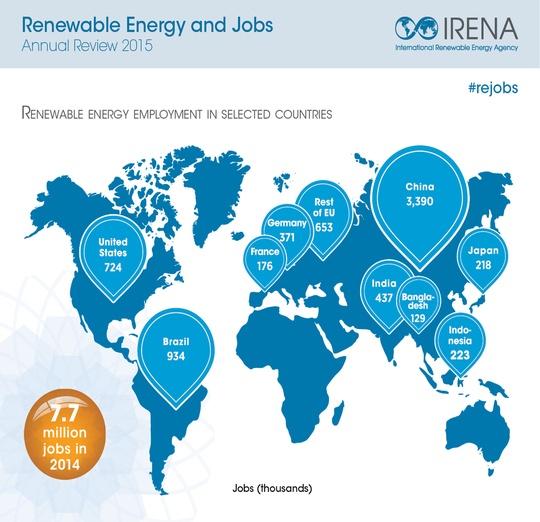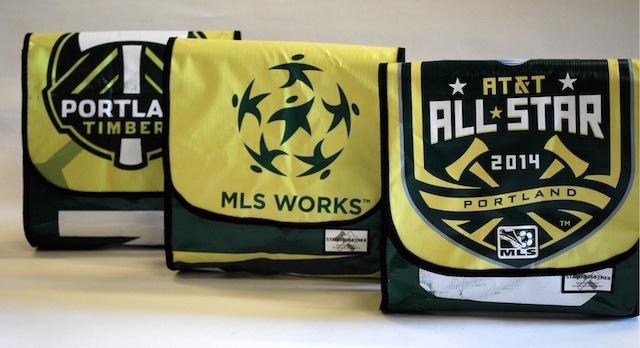Renewable Energy Now Employs 7.7 Million People Worldwide


Renewable energy investment and deployment is paying off, and in spades, when it comes to addressing a basic issue plaguing developed and developing countries alike: an inability to generate jobs that pay a good living wage. Around the world, renewable energy job creation continues to far outpace that for economies overall.
Some 7.7 million people are now employed across the global renewable energy value chain, according to the International Renewable Energy Agency (IRENA). That's up 18 percent from 6.5 million in 2014, the agency noted in its 2015 Renewable Energy and Jobs Annual Review.
In terms of technology, companies in the business of solar photovoltaic (PV) energy employ more people than any other renewable energy market segment, with most people employed in “downstream” jobs such as installing PV systems. Geographically, China's renewable energy companies employ more people than any other country. Rounding out IRENA's ranking of the top 10 countries in terms of renewable energy jobs are Brazil, the United States, India, Germany, Indonesia, Japan, France, Bangladesh and Colombia.
Studying the impacts of renewable energy job growth
Studies conclude that renewable energy deployment generates twice as many jobs, or more, compared to fossil fuel development.
Growing renewable energy investment and deployment, moreover, is doing much more than providing electrical power in countries around the world. It's helping governments, businesses and societies address a wide range of critical, interconnected social and environment issues. Renewable energy job creation, for example, is driving down the greenhouse gas emissions that are the main culprit causing rapid shifts in climate, as well as other forms of ecosystems destruction and natural resource degradation.
IRENA solicits data and information from its 140-plus members, along with a variety of other qualified sources, spanning a growing range of variables pertaining to employment and the overall impacts of renewable energy. The agency is seeing much more interest on the part of governments, as well as private-sector companies, in collecting more and better data, Dr. Rabia Ferroukhi, who heads up IRENA's socioeconomic research team, explained in an interview.
Highlights of IRENA's 2015 annual renewable energy jobs review include:
- In 2014, the solar PV sector accounted for 2.5 million jobs, two-thirds of which were in China. Solar PV jobs also grew in Japan, while decreasing in the European Union.
- Biofuels (1.8 million), biomass (822,000) and biogas (381,000) are also major employers, with jobs concentrated in the feedstock supply. While Brazil and the United States continued to dominate, Southeast Asia saw growth in biofuel jobs, reflecting measures to support production.
- Wind employment crossed the 1 million mark, with China accounting for half of these jobs. The United States, Brazil and the European Union also saw gains.
- Solar water heating and cooling employed 764,000 people, more than three-quarters of them in China. Other significant markets are India, Brazil and the European Union.
- Small hydropower employed about 209,000 people, more than half in China, followed by the European Union, Brazil and India.
- Large hydropower was estimated to support another 1.5 million direct jobs, mostly in China and largely in construction and installation.
- An array of industrial and trade policies continues to shape employment, with stable and predictable policies favoring job creation.
The manifold benefits of clean energy access
Energy access has been and continues to be a focal point of IRENA's socioeconomic research, Dr. Ferroukhi explained. Access to affordable, reliable clean energy is not only a direct driver of job creation in renewable energy businesses, but it also fosters job creation indirectly -- in what's known as induced employment.
Significantly, growing access to renewable energy addresses social discontent in developed and developing countries alike. Moreover, it's a major driver of reductions in greenhouse gases and other forms of environmental pollution that is threatening water, marine, forest and agricultural resource bases.
Environmental concerns and energy security, along with energy access, are issues near and dear to the IRENA research unit's heart, Dr. Ferroukhi said. “We're seeing that renewable energy investment, deployment and job creation is having positive impacts socially and environmentally.” Early results “clearly show the impact [renewable energy deployment] is having on emissions reductions,” she added.
Renewable energy job growth, for example, helps governments quell social discontent, an attribute that's particularly beneficial, even critical, in the Middle East and Africa region that Abu Dhabi-based IRENA calls home. With fast-growing young populations, governments need to come up with and quickly implement effective methods to spur employment among the region's youth.
"Job creation is an important element in defining renewable energy strategies and in terms of crafting policies not only regarding energy, but in terms of industrial development, trade, natural resource management and education,” Dr. Ferrouki explained.
Locking-in the course for future generations
Decisions on energy, Dr. Ferroukhi pointed out, will “lock-in societies on development paths for a long time to come.” Decisions made today, she continued, “will determine the impacts of climate change for young and future generations, as well as the outlook for jobs, economic opportunity and environmental health.
“We need to make sure today's decision-makers take these into account and institute policies today that can maximize the benefits of renewable energy investment and deployment.”
IRENA predicts that if renewable energy deployment doubles by 2030, employment across the value chain would rise to 17 million jobs.
One key aspect in this regard is the need for governments to institute much more in the way of renewable energy education and training. “There's a skills shortage, and we really need to address that now in order to double the amount of installed renewable power generation capacity,” Dr. Ferroukhi pointed out.
Overall, there's cause for cautious optimism, she added. The results of the agency's 2015 annual review “shows there's great potential” for renewable energy as a keystone of worldwide sustainable development. “But it's not going to happen in and of itself,” she said. “Government leaders need to put the right incentives and policies in place to attract developers and investment in order to maximize the benefits of deployment, which includes industrial, trade and educational policies and programs.”
*Image credits: IRENA, "Renewable Energy Jobs Annual Review 2015"
Industrial Farming’s Food for Thought


By Matthew Prescott
On a cold night last January, a cadre of investors, auditors and accountants filed into the Richard L. Knowlton Auditorium at Austin High School, in Austin, Minnesota — a small town of about 25,000 residents that sits just north of the Iowa border, about 100 miles south of Minneapolis. From their offices across the nation, they’d made the trek to Austin, through the upper Midwest’s sub-freezing temperatures, for the annual shareholder meeting of Hormel Foods — one of the world’s largest meat processors, perhaps best-known as the maker of Spam.
Among the issues to be voted on that night was a shareholder proposal submitted by the Humane Society of the United States and Calvert Asset Management — an investment group with over $13 billion in assets under management — asking Hormel to disclose the risks associated with allowing producers in its supply system to lock breeding pigs in tiny cages called gestation crates. The cages, which are so small the animals confined inside them can’t even turn around, have been widely criticized as representing cruel and unusual pig punishment. As far back as 2002, Florida legislated on the issue, becoming the first of now nine U.S. states to outlaw gestation crates.
But the issue has been brewing for decades. In 1950, the total number of farm animals in the U.S. was around 100 million; by 2007, that number had exploded to 9.5 billion. To accommodate that growth, the vast majority of farm animals have been moved off of farms and into factories. According to the USDA, during the same period over which the farm animal population increased by 9,400 percent, the number of farmers producing that population decreased by 60 percent.
So, many more animals being reared by so few farmers has come with consequences; and not many species have seen those consequences more than the pig.
“Forget the pig is an animal — treat him just like a machine in a factory,” recommended Hog Farm Management in 1976. Two years later, National Hog Farmer advised: “The breeding sow should be thought of, and treated as, a valuable piece of machinery whose function is to pump out baby pigs like a sausage machine.”
And so it was: Between the 1970s and 1990s, the majority of breeding pigs were moved into gestation crates, where they linger for months and years on end, virtually immobilized by the extreme confinement.
Unsurprisingly, the confinement has been met with substantial hue and cry. “Is That Sausage Worth This?” asked the headline of a recent New York Times piece by columnist Nicholas Kristof. “It’s like a life sentence of solitary confinement in a coffin, punctuated by artificial insemination and birth.”
The outcry has come not just from mainstream media, but from major pork-buying companies as well. More than 60 of them — from McDonald’s and Burger King to Safeway and Oscar Mayer —are in the process of freeing their supply chains of pork from gestation crate operations. Some of them, like Target and Kroger, regularly feature their policies on this issue in their corporate responsibility reports.
And for good reason. Industry data shows that consumers favor policies to improve farming conditions. Citigroup reports that “concerns over animal cruelty” can present “headline risks” to food companies. And the World Bank’s International Finance Corp. concludes that, “In the case of animal welfare, failure to keep pace with changing consumer expectations and market opportunities could put companies and their investors at a competitive disadvantage.”
And top pork producers — including the industry’s largest, like Smithfield Foods and Cargill — are responding, by eliminating gestation crates from their supply systems in favor of open pens in which the animals can move and engage in more of their normal behaviors.
But not Hormel.
So, on that cold night last January, it was the risks associated with such a position — the risks of lagging behind competition and of ignoring consumer demand, among others — that Hormel’s shareholders were being asked to vote on. The vote could either validate or give a discounting shrug toward the concerns associated with gestation crates and the animal abuse they represent.
In the meeting’s lead-up, financial experts weighed in. Institutional Shareholder Services and Glass Lewis — which provide analysis to major banks and investment firms regarding the economic merits of voting for or against such proposals — issued recommendations supporting the proposal. As ISS summarized, a vote in its favor was “warranted, as the company does not provide information about how it is evaluating and managing potential risks related to evolving regulatory and industry trends to shift away from the use of gestation crates.”
And Northern Trust, a trillion-dollar investment firm and Hormel’s eighth-largest shareholder, amended its “proxy voting guidelines” to stipulate that the firm will generally vote in favor of “proposals requesting increased disclosure or reporting regarding animal treatment issues that may impact a company’s operations and products, especially in relation to food production.”
It seemed pigs might finally have their day — and in a very real sense, they did.
The auditorium filled that night, and shareholders cast their ballots. Technically, the proposal didn’t pass; Hormel and its corporate foundation control so much company stock that it gives the company a dangerously-large amount of control over how votes like this go. That was both unavoidable and expected going into the fight.
However, excluding those shares directly controlled by Hormel, more shares were cast in favor of the proposal than against it. It was the first time a shareholder proposal on an issue related to animal cruelty received majority support from (non-company-controlled) shares.
That night, investors affirmed that, with regard to its views about animals, industrial farming’s trajectory may be at odds with that of civil society’s, and that those divergent views present tangible economic risks that companies at least ought to disclose. The proposal may not have passed, but that so many analysts urged its passage, that so many investors voted in its favor, and that such a groundswell of support from within the financial industry emerged, ought to, if nothing else, give Hormel, its shareholders, and others involved or invested in industrial farming food for thought.
Image credit: Flickr/Nick Saltmarsh
Matthew Prescott is senior food policy director for The Humane Society of the United States. He is reachable at [email protected] or on Twitter at @MatthewPrescott.
RECAP - Twitter Chat: MGM Resorts International on Women’s Leadership


MGM Resorts International and TriplePundit held a special Twitter Chat on women in leadership on May 19 at 10:30 a.m. PST/1:30 p.m. EST at #WomenLead.
This Twitter Chat highlighted why it is important for organizations to invest in the advancement of women and gave insights on how professional women can improve their leadership skills. We discussed the 2015 Women’s Leadership Conference, career development and conference content.
We covered these topics, and many more:
- Why it is important to invest in gender diversity
- How can companies measure improvements in diversity in the workplace?
- What role does confidence plays in women’s leadership?
—
FEATURED GUESTS:
Phyllis A. James (@WLCLV ) – MGM Resorts International and Women’s Leadership Conference Planning Committee
Natalie Allen (@AllenCNN) -- CNN International Anchor and Correspondent
Jen Boynton (@JenBoynton) – TriplePundit Editor-In-Chief
MODERATORS:
Nick Aster (@NickAster) — TriplePundit Founder and Publisher
Marissa Rosen (@MarissaR1) — TriplePundit Director of Social Media
Mary Mazzoni (@Mary_Mazzoni) —TriplePundit Senior Editor
About the Women’s Leadership Conference
The annual Women’s Leadership Conference is a signature program of the non profit 501(c)(3) MGM Resorts Foundation, presenting sponsor of the Conference. This Conference is the nation’s new forum to promote women’s personal and professional development and advancement. The purpose of our Conference is to inspire women to seek their highest level of personal and professional growth by presenting participants with role models, varying perspectives and strategies for development. Learn more >
About MGM Resorts International
MGM Resorts International develops, builds and operates unique destination resorts designed to provide a total resort experience, including first-class accommodations and dining, world-class entertainment, state-of-the-art meeting and convention facilities, and high-quality retail and gaming experiences. With 62,000 employees, MGM Resorts International is one of the world’s leading global hospitality and entertainment companies with 23 resorts. It has been consistently ranked among the top 500 of Newsweek Magazine’s listing of green companies. PR News has recognized MGM Resorts as an Overall Leader in CSR Practices while the Chairman & CEO has been recognized as a Responsible CEO of the Year by Corporate Responsibility Magazine.
About MGM Resorts Foundation
The purpose of the MGM Resorts Foundation is to collect and distribute monies and assets donated by employees of MGM Resorts (NYSE: MGM) for the aid and support of qualified community nonprofit programs, agencies or organizations designated exclusively by MGM Resorts employees. In addition, the Foundation collects and distributes donations to the Foundation by third-party non-employees to support charitable, scientific, literary, and educational activities approved by the Foundation’s Board of Directors and organized by MGM Resorts employees to benefit qualified non-profit charitable organizations designated by the Foundation’s Board.
As Phones, Laptops and Tablets Shrink, Challenges for Recyclers Rise


The last several decades have brought a global explosion of electronics with a huge impact on quality of life and communications, as well as the world economy.
But, like most big human-induced changes, there were unintended consequences, primarily in the form of the mountains of waste that resulted as products quickly became obsolete and tossed out only to be replaced by others with an equally short lifespan. (One study showed that 25 percent of electronic devices were used less than 500 hours before being discarded.) This is exacerbated by the fact that electronic waste can contain dangerous materials including lead, mercury and cadmium.
In the opening piece in this series, Robert Frisbee, CEO of the Green Electronics Council, spoke of the organization's mission “to rethink how a technology-centric society can continue moving toward sustainability, and to take the appropriate steps to help electronics become a cornerstone of a vibrant and healthy world.”
Indeed, numerous entities have taken action on the problem. There are now take-back laws in several European countries and American states, as part of an extended producer responsibility (EPR) movement. Many manufacturers and retailers have gotten on the bandwagon, and some have found ways to do it profitably.
But with electronic devices not only changing rapidly but getting increasingly smaller, some of the strategies that have been effectively used to recover these materials are getting more difficult to implement. To get a better handle on this, we spoke with Willie Cade, who is in the electronics recycling business, about the challenges now facing the industry.
Cade told me that things were easier when desktop and tower configurations were the norm, because those platforms were larger, designed for disassembly, and because they had reached a certain level of maturity. “They were pretty simple to carry on into a second use,” said Cade, who serves as CEO of PC Rebuilders & Recyclers in Chicago.
Standards (at least in the PC world) were eventually developed for things like hard drive interfaces and form factors, bus interfaces for printed circuit boards, CPU sockets, and memory. That meant that old PC’s could be upgraded by simply pulling out one component and replacing it with a newer one. The machines were also easier to disassemble, as screws or snap-fits were often used to hold them together.
As laptops displaced PCs in popularity, the level of standardization and upgradeability dropped.
Standardization is important for a number reasons. Companies like Cade’s could make money taking in old computers and repairing or upgrading them by simply replacing parts, then selling these in the aftermarket to people outside of what Cade calls “the digital elite.” As devices have become smaller and less standardized, the universe of individual parts has grown enormously -- making it difficult, and costly, for repair shops to keep enough inventory.
The relationship between standardization and innovation is really an interesting sideline. Because it’s only when innovation has slowed down enough for standards to be applied that third parties can get involved in the market. When they do, there is tremendous additional innovation and competition in that space. In the PC world, there was a huge aftermarket in peripherals. Laptops could still work with a wide array of standard USB devices. Now, in the mobile world, most of that innovation has migrated into software apps. It’s because of published software standards that apps can migrate from one phone to the next, while none of the hardware can, except possibly chargers and headsets.
But there is another element, literally, that has driven the economics behind recycling. That element is gold. Many electronic circuits use gold contacts and, as everyone knows, gold is very valuable. Cade says, “Gold is the economic engine behind material recovery.” Recyclers could spend a great deal to recover this gold, and still make a profit.
“Today PCs are rapidly being replaced by smartphones and tablets. These are smaller, far less standardized and are often held together with adhesives,” Cade said. The glue makes disassembly problematic. Also, the material set has changed. “What’s happened in the past couple of decades is that we went from using about 20 elements to about 70. Our best smelters in the world can recover about 20 of them from this electronics waste stream. Lithium batteries also create a problem in the recovery of the heavier, more precious metals.”
What does that mean for material recovery? “It’s kind of like the CRTs. The tablet and cellphones, which are glued together and have a battery inside, can no longer just be thrown into the fire to recover the materials.”
So, it’s become more challenging. Does that mean more stuff is ending up in landfills? Cade doesn’t think so. Because they are smaller, people tend to store them longer. “We have a lot of cell phones sitting in drawers.”
Carbon investment per device, which is primarily in the integrated circuits, has remained fairly constant, though surprisingly high. (The embedded carbon in two PCs is equivalent to one car on the road for a year.) The intensity of the new devices is higher, but since they are smaller, that evens out. Collection tonnage is going down. With all of the collection processes in place, Cade believes that the amount going into landfills today is minimal.
Computer refurbishing is a $1 billion business worldwide. But refurbishment companies are mostly working with desktops, towers and, to some extent, laptops. What happens when those give way to tablets and smartphones?
“The industry is certainly dynamic and adaptive. It will be interesting to see what happens. Any OEM who can efficiently solve the question of reuse and repair, in today’s world, is going to be a huge winner.”
EDF: Green Supply Chains a Priority for Major Companies


Big brand-name companies may not agree on very much when it comes to how to run their businesses, but it appears they do agree on the importance of “green” supply chain freight operations.
Greening the supply chain is a common thread and a “key priority” for companies, including Kellogg’s, Walmart, Anheuser-Busch, Apple, Adidas, General Mills, H&M, Lowes, CVS and Hershey, Jason Mathers wrote this month on the Environmental Defense Fund business blog.
“While each company has its own unique sustainability challenges and priorities, every one of them has a global supply chain that requires an extensive logistics network to move goods from manufacturing facilities to end customers,” he wrote.
After reading through the corporate responsibility reports of those major brands — thanks for doing that Jason! — he outlined three trends that stand out when it comes to green freight operations:
- Tracking logistics emissions is a standard practice. Seven out of the 10 recently released reports included data on fuel use or greenhouse gas emissions associated with freight transportation. “Several companies were tracking only emissions from outbound freight transportation, presumably because of a lack of visibility into inbound moves,” he wrote. Adidas, one of the three that did not include information on emissions or fuel use from freight movement, has included a breakdown of moves by transport modes and emissions from distribution centers and other facilities.
- Setting performance goals is a well-accepted practice. Four of the 10 companies have “performance-based goals” to improve the environmental impacts associated with freight transportation. For example:
- Walmart is seeking to double its fleet efficiency compared to 2005, and is nearly 90 percent there to meeting this goal.
- General Mills has a goal to reduce fuel use for its outbound moves by 35 percent compared to its 2005 consumption. The company has made considerable progress, reducing fuel use by 22 percent compared to 2005.
- Anheuser-Busch set a goal in 2014 to reduce greenhouse gases from its global logistics operations by 15 percent per hectoliter sold. Its goal also has a broad scope, including inbound and outbound transportation as well as warehousing.
Walmart has embraced this dynamic, he continued, by identifying “several key success factors for driving greater efficiency across the industry.” At the top of the list were policy outcomes, including next-generation fuel efficiency and greenhouse gas standards for freight trucks. Walmart noted in its latest sustainability report that policies like the “phase 2 GHG rule can present key opportunities to improve efficiency across the industry in a coordinated, responsible and safe way.”
EDF has urged the Environmental Protection Agency and the Department of Transportation to set new fuel efficiency and greenhouse gas standards for heavy trucks that will cut fuel consumption by 40 percent in 2025 compared to 2010.
The EDF says there are many ways to reduce freight-related greenhouse gas (GHG) emissions. But what strategies make the most sense? EDF’s comprehensive 67-page Green Freight Handbook helps companies answer that question, because it’s based on the “initiatives that will achieve the greatest environmental benefit in the least amount of time.” Another answer is the Green Freight Diagnostic Tool, which focuses on “five key principles” for greener freight:
- Get the most out of every move
- Choose the most carbon-efficient mode
- Collaborate
- Redesign your logistics network
- Demand cleaner equipment and practices
While it may seem that greening long, complex supply chains is a daunting and nearly impossible task, the EDF’s work on freight provides useful, common-sense tools and steps that help guide companies serious about green supply chains.
Image extracted from the EDF’s Green Freight Handbook
Driscoll's Berries on the Front Lines of Climate Change


We live in strange times. One in 3 people around the world are overweight, and around the world 24 percent of calories are wasted between the farm and the refrigerator. That number jumps to 42 percent for folks in the U.S. Meanwhile, some 805 million people in the world (1 in 9 of us planetary residents) do not have enough food to lead a healthy, active life: abundance and scarcity, hand in hand.
The reasons for this dichotomy are numerous, and the solutions complex. But one berry farmer hopes to tackle it with industry leadership and smart water management. J. Miles Reitner, chairman of Driscoll's Inc., spoke from the plenary stage at the 2015 Ceres conference about his company's efforts to lead the way on smart water use and the best growing conditions for strawberries.
"There's a very specific climate for strawberries," Reitner said. "Coastal valleys are perfect. [Driscoll's operates] in 21 countries, and none of the growing environments is quite as perfect as California. We don't have a mobility choice. That means we need to fix the water situation."
Driscoll's, a family company, looks one or two generations out when planning and forecasting water needs. That means the current drought situation in California is quite worrisome, because water for farming will not be around for future generations if the aquifers are depleted.
The Driscoll's approach to water management rests on three principals:
- Agriculture is important to the California Central Valley, U.S. and world Because California produces much of the produce eaten in homes all around the U.S. and is fondly referred to as the nation's breadbasket.
- Imported water is non-viable
Due to the high cost of importing water from far away and the relatively low cost of produce, bringing in water from another region is not going to work economically. - Agriculture is a big part of the problem and needs to be a big part of the solution California's approach to water rights has historically focused on longevity, and doesn't necessarily incentivize efficiency measures. That needs to change, given that the agriculture industry accounts for 80 percent of the water use in the state.
To put these goals into action, Driscoll's established a formal forum for dialogue and collaborative projects with more than 50 community leaders from the Pajaro Valley, so that people could collaborate on ways to save water.
One of Driscoll's first moves was to come out in favor of groundwater legislation that many growers opposed due to the increased costs and restrictions. When asked why, Reiter explained:
"We're a family-owned company; we look out over one or two generations. This legislation is in the public interest. It's in California's interest to have water management. California was the only state that didn't have groundwater management." He claims he didn't get flack from other farmers because they knew legislation was in their industry's best interest over the long term, even if it caused short-term pains.
In addition to water management, Reiter called for a carbon tax, which could raise the cost of production as it would increase the cost of oil. "Cheap food is one of the problems in our country," he explained, alluding to the fact that agriculture subsidies go mostly to corn and soybean growers in the Midwest, who produce cheap and copious ingredients for calorie-rich food without much nutritional value.
Driscoll's is hard at work figuring out how to efficiently produce berries with a minimum input of water without sacrificing taste or volume. In fact, Reiter pointed to taste as a key to healthier eating: "Fruit needs to taste better: We can shift people to healthier diets if the product tastes good." He joked that even his children won't eat berries that aren't tasty. To close things out, Reiter called on the culinary world to "get more creative with plant-based food. Animal-based entrees are a cop-out for poor skills."
While many gourmands would probably disagree with Reiter there, there's no doubt that reducing meat consumption is one quick way to save water and improve health outcomes.
Does that mean strawberry shortcake for dinner this summer?
Image credit: Flickr/Jeepers Media
Apple Talks Corporate Social Responsibility


Editor’s Note: This article originally appeared in the May issue of Green Money Journal.
By Bennett Freeman
Over the last decade, Apple has become one of the most iconic brands in the world. It stands for innovation — innovation in its technology, design and product experience. And it has been a magnet for responsible investors, whose portfolios have been served well by holding the company.
At the same time, like its peers and competitors in the consumer electronics industry, it faces tough issues around labor and human rights in its relationships with its suppliers — some of which manage massive workforces in countries such as China. Apple has been a leader in the supplier responsibility space, but has learned that it is difficult — if not impossible — to achieve the same level of perfection on these issues as it does in its products.
Jacky Haynes, Apple’s senior director of supplier responsibility, has been at the forefront of the company’s efforts to manage these relationships. Unlike many of her peers at other companies, she has built her career in operations and on factory floors, giving her a unique perspective on how supply chains and assembly lines work — and an unusually informed perspective on workers and workforce management. Jacky has been tireless in her work with Apple’s suppliers, but she's the first to admit that she is constantly learning new lessons along the way on how the company can continue to improve its approach to these complicated issues.
I sat down with Jackie to hear her thoughts on corporate social responsibility (CSR) and supply chain management.
Bennett Freeman: Unlike many other companies, Apple’s social responsibility team sits within its operations team. What are some of the insights you bring from your many years on the operations side of Apple to the company’s social responsibility function?
Jacky Haynes: The way we think about supplier responsibility at Apple is that it’s entirely intertwined with operations. We can’t do the work we do, deeply embedded in the supply chain, without the operations team. They are as likely to knock on my door to ask for help as I am to knock on their door. I came into this role with 30 years of experience in operations, so I have real experience and relationships in that world. I can tell you without a doubt I would not have come back from retirement to take this job if we did not have a management team, up through and including our CEO Tim Cook, who was totally committed to the work we are doing.
At Apple, we believe that every worker in our supply chain has the right to safe and ethical working conditions. That’s just not a slogan on our website; it’s something we live and breathe every single day. And it’s not just the responsibility of my team; it’s also the responsibility of the hundreds of Apple employees in our factories every single day. One of the things that really distinguishes the work we do in supplier responsibility is that we have boots on the ground all the time. I don’t believe that my job can be done from behind a desk, so I spend a lot of time with my team in the factories talking to managers and attending audits.
BF: In the wake of the New York Times investigative reporting on Foxconn in early 2012, Apple faced sharp scrutiny regarding its supply chain practices and has addressed these issues by joining the Fair Labor Association and strengthening its policies and management systems in recent years. What improvements have been made and what lessons has the company learned?
JH: In fact, we’d been working on these issues for some time. We had what we believed to be — and still do believe — one of the strongest codes of conduct in the industry. I think we had to learn that this work is a journey. We really looked at ourselves and realized that we don’t know if, when and how we’ll ever be done, no matter how good of a job we are doing.
We care so much about perfection in our products. We want that same level of perfection in our supply chain, but it’s very hard. So I’d say looking in the mirror and dealing with that reality was a very, very difficult thing for us to do, and so we redoubled our efforts on many fronts.
Our first lesson was that we needed to be sure that we were designing supplier responsibility programs with the same level of attention to detail and innovation that we bring to our products—and we need to be able to do that at Apple scale. And for Apple, scale means that our top 200 suppliers manage over 750 facilities worldwide at all levels of our supply chain — and manage over 1.5 million workers. So, that’s the challenge ahead of us.
We learned that we really needed to focus on tackling the root causes of any issues we observed within the supply chain. For example, we saw that workers weren’t wearing the appropriate personal protective equipment. It wasn’t that workers were intentionally violating the policy, but that factories didn’t have properly trained people to evaluate workers’ health and safety and put a program into place. So we took that observation, among others, and launched the Environment, Health, and Safety Academy to try to address the root cause of some of the health and safety violations.
And then finally, we realized we needed to be more transparent and open around the work that we are doing. If you look at our reports for the past three years, we have increasingly added transparency into our reporting, including listing our suppliers, our smelters in the conflict minerals program, and the standards that sit behind our code of conduct. We think it’s really important to talk to our friends, our critics, and our partners about the work that we are doing, because hopefully we can inform them and they can inform us, and we’ll improve.
Read the complete interview here.
Image credit: Flickr/Aurimas
Bennett Freeman was the Senior Vice President for Sustainability Research and Policy at Calvert Investments for nine years from April 2006 through April 2015.
Engaging Fans and Sponsors Through Sustainable Products


Editor’s Note: This post is part of a student blogging series on The Business Of Sports & Sustainability. Students attend the Presidio Graduate School which offers the only MBA-level sustainability program focused exclusively on the sports industry. You can follow the series here.
By Kari Brizius
How do you turn a waste stream into a fan engagement tool and involve sponsors?
First, take a billboard or a banner that was a piece of the stadium, the team, the sponsor or the event. Second, turn it into usable products. And, third, let the fans take it home! That’s a win-win for everyone.
The team and stadium reduce waste and their cost to ship non-recyclables to the landfill. The sponsor also reduces waste and gets unique branded products in front of the fans. And the fans get to take a piece of the game home with them. It’s a home run for everyone and almost as good as catching a home run ball at a baseball game.
Since vinyl (PVC or polyvinylchloride) is not recyclable, when it is no longer used it goes to the landfill -- where it stays, forever! It does not break down; it does not go away. It simply fills up space in the landfill. Over 600,000 tons of vinyl billboards and banners are produced each year and, traditionally, it goes directly to the landfills. There has to be a better solution or a new solution to make use of this material. So, instead of disposing of it, why not use it as feedstock for upcycled fan engagement products.
When we talk about banners and billboards here is a sampling of all the material this includes:
- Vinyl wrapping posts at a stadium or jewel event
- Vinyl outfield walls at baseball stadiums
- In-ice mesh at hockey arenas
- Player banners that hang around the parking lots
- Finish-line material for marathons and bike races
- Mesh that lines parade routes, construction sites and race routes
- Street pole banners around each city
If the goal is zero waste, we need to devise cyclical systems, similar to nature, where there is no waste. We need to start looking at all material that is traditionally discarded and use it as feedstock for new products. This is not a new idea, but is still not widely accepted or practiced. Currently, most teams and venues do not realize the value of reusing this branded material and either store the vinyl or throw it in the trash. And few take any responsibility for the billboards they post.
But there is hope! Teams are seeing the value for fan engagement. The Portland Timbers mailed their season tickets in upcycled banner document cases. They also turned the banners from the MLS All-Star Game into one-of-a-kind messenger bags and totes. The NCAA Final Four turned their street pole banners from New Orleans into iPad cases (2012); banners from around the event at the Georgia Dome into messenger bags (2013); and will repurpose the banners from this year’s event in Indianapolis through a local organization. The Waste Management Phoenix Open turned the banners from around the course into totes that are sold online. The Super Bowl donates their banners to local organizations and nonprofits to turn into items like shower curtains and clothes to help raise funds. The Tampa Bay Lighting repurposed banners and uniforms into products for VIPs and to sell in their store.
So, how do you involve the sponsors? Why would they care? Sponsors frequently purchase fan engagement products to get their name out in front of fans. Their logos are everywhere. Creating repurposed products promotes a positive engagement with fans about their brand and what it stands for. The fact is, yes, fans do care about sustainability. The stats presented by the Green Sports Alliance and Turnkey Intelligence back up this assertion. The study shows that 81 percent of sports fans express concern for the environment, and 58 percent expect teams and leagues to use environmentally friendly practices. Taking responsibility for sustainability takes behavior change and teams willing to lead by example. Engaging fans through sustainable messaging, especially with items that they can touch and feel, is a huge win for everyone.
Teams and sponsors can promote sustainability to their customers and stakeholders through the repurposing/upcycling of their billboards and banners into unique, one-of-a-kind, branded products. The right products will engage fans, employees and stakeholders, and your brand will circle the world promoting the team, the sponsors and your sustainability mission. Ultimately, the value in upcycling this marketing waste stream goes far beyond just sustainability; it adds even more to the triple bottom line of people, planet, and profits.
Teams and sponsors have an opportunity to drive brand loyalty and engage fans through their sustainability commitments. By creating new, sustainable, branded product incentives, companies can communicate their sustainability goals, engage fans and drive profits to the bottom line. The more products are created from existing materials, the less waste is going to all of our landfills and the lower carbon footprint of creating new materials.
Image credit: Della Simpson, Relan
Kari Brizius, President of Relan, is a mother of two, West Point graduate, U.S. Army veteran and certified personal trainer. Her love of a healthy lifestyle, exercise, and the environment led her to pursue a for-benefit company with her mother. LinkedIn Twitter: @RelanBag
Why Sacred Places Should Matter, Even to Business Folks


By Christopher McLeod
In the last month, Native Hawaiians blockaded construction machinery headed for the top of sacred Mauna Kea, where a 30-meter telescope is to be built. Thirty-one people were arrested. In Arizona, members of the San Carlos Apache Tribe walked 45 miles to Oak Flats and occupied a ceremonial initiation site that the U.S. Congress handed over to a London-based mining company for a copper mine. In California, the Winnemem Wintu Tribe continues their fierce opposition to government plans to raise the height of Shasta Dam, which would flood Winnemem sacred sites.
Sacred places are alive in the hearts and minds of native people around the world. Mountains, springs, lakes, rivers, trees, groves, caves — these are sites of ceremony, inspiration and learning. From Mount Fuji to Uluru, from Taos Blue Lake to the Grand Canyon, sacred lands anchor peoples’ souls to earth.
The public relations push to proclaim national parks as “America’s Best Idea” missed an important historic fact: Sacred places are the oldest protected areas on the planet. This is an old idea. Perhaps it has been buried by monotheistic Christian ideals that instruct man to dominate nature, or capitalist market values that dictate extraction and profit off land that is bought and sold. But long before there was a “protected area movement” to counter environmental threats, there were culturally protected places on every continent. And there still are.
Sacred lands are more than esoteric, spiritual sanctuaries. These places protect biodiversity. The World Bank reports* that indigenous people make up 4 percent of the world’s population and control 22 percent of the earth’s surface — and on that land is 80 percent of the planet’s remaining biodiversity. People whose connection to land goes back centuries and who have maintained cultural value systems rooted in sacred places have a superior land ethic. Period.
Over the last 10 years, I have traveled around the world documenting the uniqueness of indigenous cultures and the universality of values that honor the sacred spiritual dimension of land and water. Reciprocity. Reverence. Respect. Relationship. Yet everywhere I go, aboriginal lands are under siege, as new technology and energy addictions push corporations into more and more remote places to satisfy global demand.
The resulting film series, "Standing on Sacred Ground," shows Altaians in Central Asia fighting Russia and China’s plan to build a natural gas pipeline across a sacred burial ground on the Ukok Plateau, a World Heritage site. In Alberta, Canada, First Nations people suffer an epidemic of cancer, pull deformed fish from rivers and lakes, yet face a government that is totally supportive of a tar sands industry it helped create. In Peru, the Q’eros make pilgrimage to sacred mountains, their apus, but see glaciers — their water source — disappearing before their eyes as far-off carbon emissions warm the Andes.
Sacred places are important to hundreds of cultures that have suffered at the hands of missionaries who have warned them of their sins—including veneration of nature. As Winona LaDuke says in the film, “Sacred places are spiritual recharge areas, places of reverence where we are not only careful, but prayerful. In those places we reaffirm our relationship to our relatives, to spiritual beings, and to the land that is the source of our power.”
Ceremony, prayer and ritual still connect families and communities to land in a bond of love, affection and spiritual obligation. It’s what many in urban industrial civilization now crave. Sacred places should be at the heart of every region’s sustainability plan for the future, with indigenous people leading the way to create a new economic model and a new land ethic that can help heal our alienation from nature.
The tipping point that will signal the transition back to honoring land as sacred could come with the denial of the Keystone XL pipeline, and not just because it is a climate killer that threatens the Ogallala Aquifer. Keystone should be denied because it is dirty oil destined for the U.S. that is killing people, wildlife, rivers and forests in Alberta. It is unethical, immoral oil. It’s a violation of all that is sacred.
Davianna McGregor is one of a band of Native Hawaiians who created the Protect Kaho`olawe Ohana in the 1970s and successfully won a sacred island back from the U.S. Navy, which had used Kaho`olawe as a bomb testing range for 50 years. McGregor says, “Christianity severed the relationship of our soul to the land. Kaho`olawe gave us a connection to our ancestors and spiritual beliefs, and we were able to call back our gods.”
In addition to legal protection for sacred places, what we need is an apology, from the U.S. government to Native Americans and indigenous people elsewhere whose lands have been violated. We need reconciliation between cultures and with the land. This could unleash a cultural renaissance for indigenous people, and also for western civilization, painfully disconnected from nature but fully capable of remembering we are part of it, not superior to it.
Christopher “Toby” McLeod directs the Sacred Land Film Project. His most recent film series, the award-winning Standing on Sacred Ground, tells the stories of eight embattled indigenous communities around the world. It is now airing on public television stations around the country. Read more at StandingOnSacredGround.org or check out the trailer.
Why We Should Teach Everyone Character


By Shannon Houde
An organization in the U.S. is teaching kids character. Yes, really. They've developed an educational framework for schools that supports the "social, emotional and ethical development of students." Or, as Daniel Goleman would term it: emotional intelligence. Now that’s just core character if I have ever heard it!
Sounds odd though, right? When I was at school the idea of teaching character would have been laughed out of the classroom. Character was something that we were expected to acquire over time and accrue somewhere between the rocks and hard places of life. Challenging life experiences were 'character building.' The message was clear: You had to earn it. Blood, sweat and tears. My parents sent me into the woods for a month when I was 16 to toughen me up, and just the stench of 30 teenagers in small tents with no shower for that long gave me a kick in the character pants. I keep saying I want both my boys to be in the military like my Navy dad, so they too learn character.
So, when I saw this article, I was intrigued by the idea that someone was trying to formally teach it in schools and curious about the potential applications for my career coaching clients and the sustainability sector as a whole. Maybe these guys were on to something. I'm a executive coach and talent advisor, and I spend a lot of time analyzing the concept of leadership: what it is, how to cultivate it, how to mentor it, how to hire it, how to work with it, and how to use it to push sustainability and innovation forward. I was already convinced that good character is a cornerstone of great leadership and that great leadership is a cornerstone of better -- and more sustainable -- business. What's more, I already knew that in the sustainability jobs market, the hallmarks of good character -- authenticity, integrity, accountability and a commitment to walking the talk -- are at a premium. So, the question followed quite easily: If you can teach character to children, can you teach it to our future leaders, too?
Much like sustainability itself, character is a heterogeneous concept that's hard to define in any tangible way. For the purposes of this post, I'm thinking about the role an educational framework might play in equipping the next generation of leaders with the key competencies they'll need to deliver the sustainability agenda. Certainly worth more than geometry class, no? In my experience from working with more than 3,000 sustainability practitioners over the past decade, I have found that the top five key competencies for sustainability are:
- Bravery and resilience
- Ability to balance global and local perspectives
- Innovative- and systems-thinking
- Influencing and negotiating
- Engaging others on the journey on their own terms
Social, emotional and ethical development -- to quote Character.org -- is the bedrock of the soft skills that underlie these competencies, and that makes teaching character a no-brainer.
But how? There are a couple of routes worth exploring such as a professional mentoring relationships in which -- as this Forbes article explains – “self-aware, patient and empathic people with strong listening skills who are committed to using their strategic insight, technical expertise and industry knowledge can contribute to a junior's personal growth and professional development." The downside is that it's on a one-to-one basis and so by its nature is not available to everyone.
Another is Business in the Community's competency map: a useful online tool that uses interpersonal, personal and organizational themes to break down the skills, values and traits needed for strong sustainability leadership. The behaviors described in it could be considered the professional hallmarks of good character. I've admired this framework before and found it useful to help the jobseekers I work with to clarify their thinking around what makes a great leader. But looking at it now, I think it's missing something: an outer ring, going the whole way around, with just one word in it (I'll let you guess what...).
Competency maps help us conceptualize the challenge of embedding good character traits in the workplace, and mentoring relationships can give a small percentage of elite future leaders bespoke one-on-one coaching -- but maybe that's not enough. Maybe what we need is a formalized, across-the-board, open access professional development offering for businesses what Character.org is doing for schools and communities. What kind of an impact would that sort of education and support have on the delivery of sustainability goals and our developing future leaders?
According to the director of the Institute for Leadership and Sustainability at the University of Cumbria Business School, Jem Bendell: "Leadership should be about helping people do difficult things together that they wouldn’t otherwise do, so sustainability leadership is a useful term when talking of helping society transition to a totally different way of life.”
From this perspective, we all need to be sustainability leaders -- whether we have a C-suite role or not. He says: "Just because you don’t have a position of power does not mean you can’t change things." I say: Good character will be what makes us try. So, let's teach it.
If you are interested in leadership coaching, executive coaching or character training please contact us.
Image credit: Taigo, via Flickr
Shannon Houde is founder of Walk of Life Consulting, the first international career and executive coaching business focused solely on the environmental, sustainability and corporate responsibility fields.